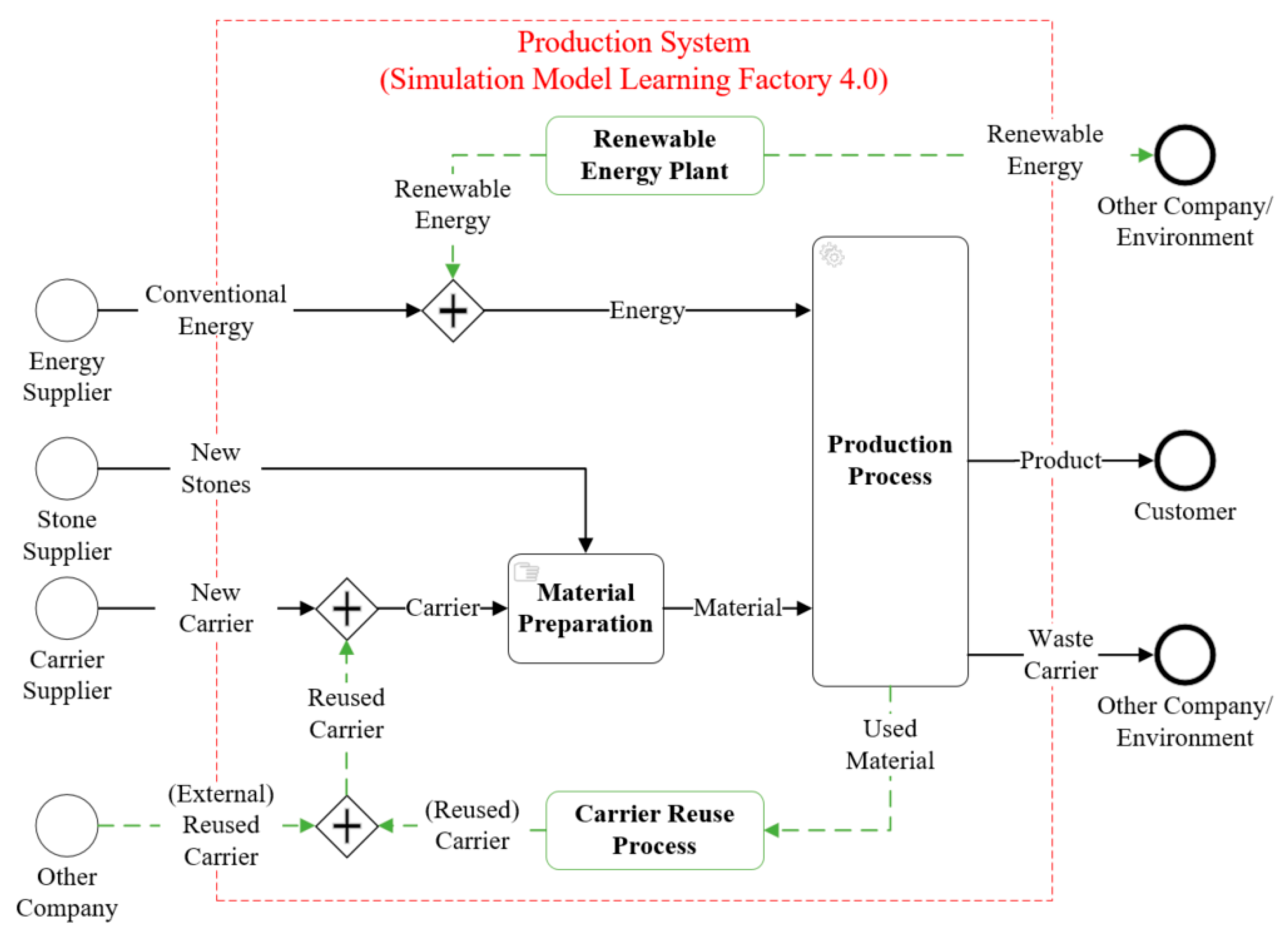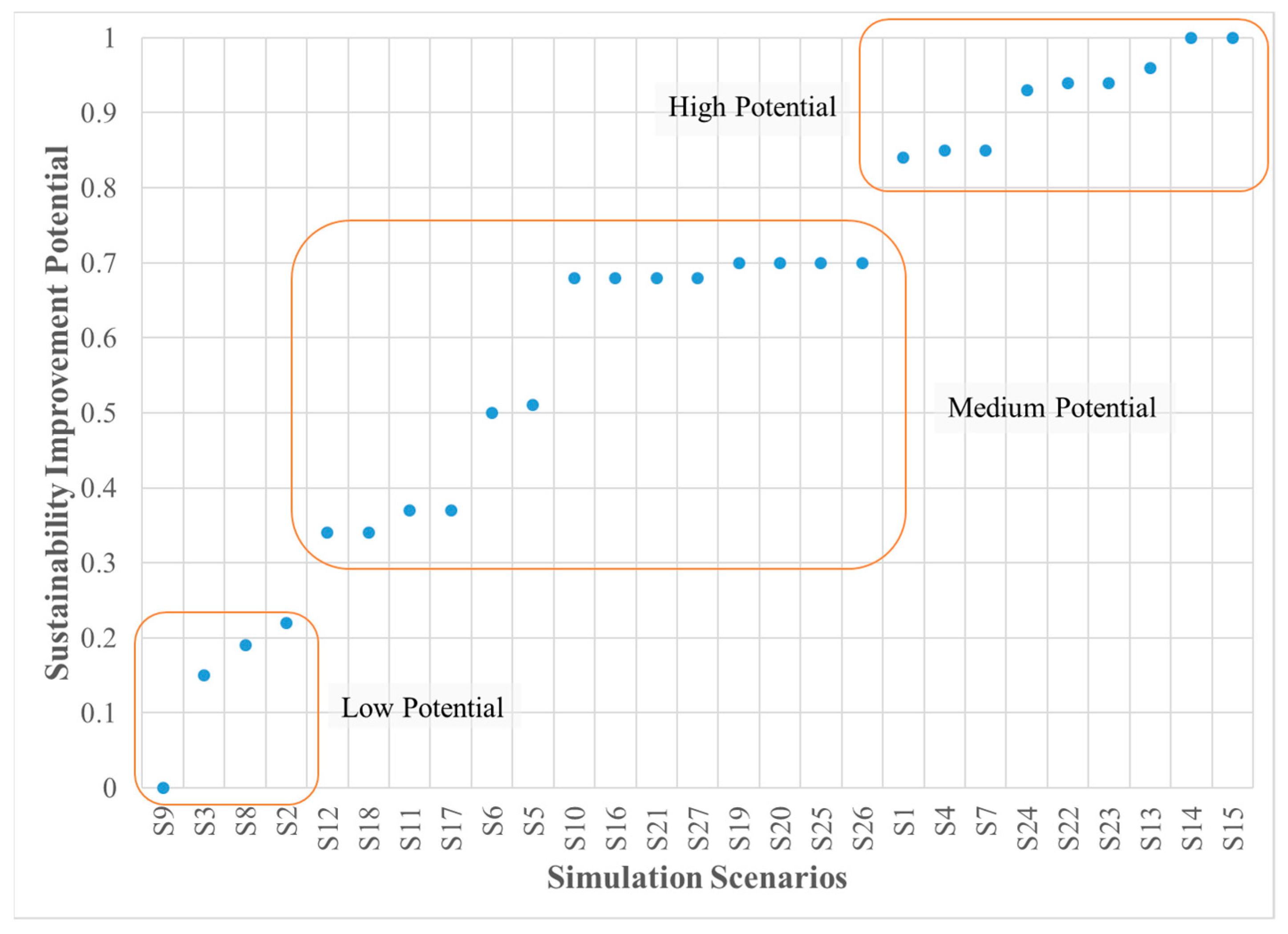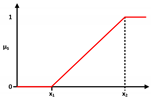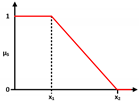Problems, Needs, and Challenges of a Sustainability-Based Production Planning
Abstract
:1. Introduction
2. Literature Review
2.1. Definition of Production Planning According to Sustainability Aspects
2.2. Decision-Making Methods for Production Management According to Sustainability Aspects
3. Scope of the Case Study
3.1. Production and Sustainability Goals
3.2. System Boundaries of the Learning Factory
- If the renewable energy generation is equal to the energy demand, no renewable energy is sold to other companies.
- If the renewable energy generation is higher than the energy demand, the production program can be changed to increase the renewable energy demand, renewable energy can be stored, or renewable energy can be sold to other companies.
- If the renewable energy generation is lower than the energy demand, the production program can be changed to decrease the energy demand, or energy needs to be satisfied by purchasing from an external energy supplier, which causes higher energy costs and (in the case of conventional energy) indirect GHG emissions. Therefore, the energy demand should be reduced as long as it is economically possible.
4. Formulation of the FIM for Sustainability-Based Production Planning
- Determination of membership functions for the fuzzification process;
- Selection of fuzzy operators for the inference model;
- Definition of functions for the defuzzification process.
4.1. Fuzzification
4.2. Inference Model
4.3. Defuzzification
- Low improvement potential indicates a high state of sustainability. Therefore, no more action is required to change the production program. The range should be as close as required to zero because higher values decrease the planning effort to reach a low sustainability state.
- High improvement potential indicates a low or medium state of sustainability and high production flexibility. Therefore, the production program can be adjusted to improve sustainability. According to the expected model outcome, the range should begin between 0.55 and 0.75, which was determined by initial simulation experiments.
- Medium improvement potential indicates a low or medium state of sustainability and low production flexibility. The production must be adjusted to increase production flexibility. The range is between low and high potential to improve the production program.
5. Case Study Results for Sustainable Production Planning
5.1. Simulation Parameter and Scenarios
- It was assumed that the production goal (f) was always fully achieved.
- The accumulated work stress started at zero.
- A total of 1000 Monte Carlo simulation runs were performed to determine the average values.
5.2. Case Study Results
5.3. Case Study Results, Discussion, and Limitations
6. Discussion
7. Results and Outlook
Author Contributions
Funding
Institutional Review Board Statement
Informed Consent Statement
Data Availability Statement
Conflicts of Interest
References
- Stock, T.; Seliger, G. Opportunities of Sustainable Manufacturing in Industry 4.0. Procedia CIRP 2016, 40, 536–541. [Google Scholar] [CrossRef] [Green Version]
- WCED. Our Common Future; Oxford Paperbacks; Oxford University Press: Oxford, UK, 1987.
- Elkington, J. Partnerships from cannibals with forks: The triple bottom line of 21st-century business. Environ. Qual. Manag. 1998, 8, 37–51. [Google Scholar] [CrossRef]
- Meadows, D.H. The Limits to Growth: A Report for the Club of Rome’s Project on the Predicament of Mankind, 2nd ed.; Universe Books: New York, NY, USA, 1974; ISBN 0-87663-165-0. [Google Scholar]
- Meadows, D.H.; Randers, J.; Meadows, D.L. Limits to Growth: The 30-Year Update; Chelsea Green Publishing Company: White River Junction, VT, USA, 2004; ISBN 9781931498586. [Google Scholar]
- Intergovernmental Panel on Climate Change. Global Warming of 1.5 °C: An IPCC Special Report on the Impacts of Global Warming of 1.5 °C above Pre-Industrial Levels and Related Global Greenhouse Gas Emission Pathways, in the Context of Strengthening the Global Response to the Threat of Climate Change, Sustainable Development, and Efforts to Eradicate Poverty; Masson-Delmotte, V., Zhai, P., Pörtner, H.-O., Roberts, D., Skea, J., Shukla, P.R., Pirani, A., Moufouma-Okia, W., Péan, C., Pidcock, R., et al., Eds.; Intergovernmental Panel on Climate Change: Geneva, Switzerland, 2018. [Google Scholar]
- United Nations. Paris Agreement. Available online: https://unfccc.int/files/meetings/paris_nov_2015/application/pdf/paris_agreement_english_.pdf (accessed on 17 February 2022).
- United Nations. Transforming Our World: The 2030 Agenda for Sustainable Development. Available online: https://www.un.org/ga/search/view_doc.asp?symbol=A/RES/70/1&Lang=E (accessed on 17 February 2022).
- Handelsjournal. Transparenz ist Trumpf. Available online: https://www.handelsjournal.de/unternehmen/marketing/transparenz-ist-trumpf.html (accessed on 14 January 2022).
- Bhanot, N.; Rao, P.V.; Deshmukh, S.G. An integrated approach for analysing the enablers and barriers of sustainable manufacturing. J. Clean. Prod. 2017, 142, 4412–4439. [Google Scholar] [CrossRef]
- Sun, Y.; Guan, W.; Asif, R.; Shahzad, M.; Binh An, N. Transition towards ecological sustainability through fiscal decentralization, renewable energy and green investment in OECD countries. Renew. Energy 2022, in press. [Google Scholar] [CrossRef]
- Gronau, N. Enterprise Resource Planning: Architektur, Funktionen und Management von ERP-Systemen, 3rd ed.; [umfassend überarbeitete und aktualisierte] Auflage; De Gruyter Oldenbourg: München, Germany, 2014; ISBN 9783486755749. [Google Scholar]
- Giret, A.; Trentesaux, D.; Prabhu, V. Sustainability in manufacturing operations scheduling: A state of the art review. J. Manuf. Syst. 2015, 37, 126–140. [Google Scholar] [CrossRef]
- Hemdi, A.R.; Saman, M.Z.M.; Sharif, S. Sustainability evaluation using fuzzy inference methods. Int. J. Sustain. Energy 2013, 32, 169–185. [Google Scholar] [CrossRef]
- Jamwal, A.; Agrawal, R.; Sharma, M.; Kumar, A.; Luthra, S.; Pongsakornrungsilp, S. Two decades of research trends and transformations in manufacturing sustainability: A systematic literature review and future research agenda. Prod. Eng. Res. Devel. 2022, 16, 109–133. [Google Scholar] [CrossRef]
- Kamble, S.S.; Gunasekaran, A.; Gawankar, S.A. Sustainable Industry 4.0 framework: A systematic literature review identifying the current trends and future perspectives. Process Saf. Environ. Prot. 2018, 117, 408–425. [Google Scholar] [CrossRef]
- Turban, E.; Aronson, J.E.; Liang, T.-P. Decision Support Systems and Intelligent Systems, 7th ed.; Prentice-Hall of India: New Delhi, India, 2005; ISBN 9788120329614. [Google Scholar]
- Akbar, M.; Irohara, T. Scheduling for sustainable manufacturing: A review. J. Clean. Prod. 2018, 205, 866–883. [Google Scholar] [CrossRef]
- Vorderwinkler, M.; Heiss, H. Nachhaltige Produktionsregelung. Bundesminist. Verk. Innov. Techno 2011, 40, 2011. [Google Scholar]
- Daly, H.E. Toward some operational principles of sustainable development. Ecol. Econ. 1990, 2, 1–6. [Google Scholar] [CrossRef]
- REFA. Planung und Gestaltung Komplexer Produktionssysteme, 2nd ed.; Hanser: München, Germany, 1990; ISBN 3446159673. [Google Scholar]
- DKE. Enterprise-Control System Integration—Part 1: Models and Terminology; CEN: Brussels, Belgium, 2013. [Google Scholar]
- Graves, S.C. Manufacturing Planning and Control. Available online: https://www.researchgate.net/publication/246760677_Manufacturing_Planning_and_Control (accessed on 17 February 2022).
- Sutherland, J.W.; Richter, J.S.; Hutchins, M.J.; Dornfeld, D.; Dzombak, R.; Mangold, J.; Robinson, S.; Hauschild, M.Z.; Bonou, A.; Schönsleben, P.; et al. The role of manufacturing in affecting the social dimension of sustainability. CIRP Ann. 2016, 65, 689–712. [Google Scholar] [CrossRef] [Green Version]
- Moldavska, A.; Welo, T. The concept of sustainable manufacturing and its definitions: A content-analysis based literature review. J. Clean. Prod. 2017, 166, 744–755. [Google Scholar] [CrossRef]
- USEPA. Sustainable Manufacturing. Available online: https://www.epa.gov/sustainability/sustainable-manufacturing (accessed on 12 January 2022).
- Zarte, M.; Pechmann, A.; Nunes, I.L. Decision support systems for sustainable manufacturing surrounding the product and production life cycle—A literature review. J. Clean. Prod. 2019, 219, 336–349. [Google Scholar] [CrossRef]
- Khaled, M.S.; Shaban, I.A.; Karam, A.; Hussain, M.; Zahran, I.; Hussein, M. An Analysis of Research Trends in the Sustainability of Production Planning. Energies 2022, 15, 483. [Google Scholar] [CrossRef]
- Zarte, M.; Pechmann, A.; Nunes, I.L. Fuzzy Inference Model for Decision Support in Sustainable Production Planning Processes—A Case Study. Sustainability 2021, 13, 1355. [Google Scholar] [CrossRef]
- Zarte, M.; Pechmann, A.; Nunes, I.L. Indicator framework for sustainable production planning and controlling. Int. J. Sustain. Eng. 2019, 12, 149–158. [Google Scholar] [CrossRef]
- Herva, M.; Roca, E. Review of combined approaches and multi-criteria analysis for corporate environmental evaluation. J. Clean. Prod. 2013, 39, 355–371. [Google Scholar] [CrossRef]
- Diaz-Balteiro, L.; González-Pachón, J.; Romero, C. Measuring systems sustainability with multi-criteria methods: A critical review. Eur. J. Oper. Res. 2017, 258, 607–616. [Google Scholar] [CrossRef]
- Joung, C.B.; Carrell, J.; Sarkar, P.; Feng, S.C. Categorization of indicators for sustainable manufacturing. Ecol. Indic. 2013, 24, 148–157. [Google Scholar] [CrossRef]
- Yu, E.P.-y.; van Luu, B.; Chen, C.H. Greenwashing in environmental, social and governance disclosures. Res. Int. Bus. Financ. 2020, 52, 101192. [Google Scholar] [CrossRef]
- Inoue, M.; Lindow, K.; Stark, R.; Tanaka, K.; Nahm, Y.-E.; Ishikawa, H. Decision-making support for sustainable product creation. Adv. Eng. Inform. 2012, 26, 782–792. [Google Scholar] [CrossRef]
- Ghadimi, P.; Dargi, A.; Heavey, C. Sustainable supplier performance scoring using audition check-list based fuzzy inference system: A case application in automotive spare part industry. Comput. Ind. Eng. 2017, 105, 12–27. [Google Scholar] [CrossRef] [Green Version]
- Kucukvar, M.; Gumus, S.; Egilmez, G.; Tatari, O. Ranking the sustainability performance of pavements: An intuitionistic fuzzy decision making method. Autom. Constr. 2014, 40, 33–43. [Google Scholar] [CrossRef]
- Pislaru, M.; Herghiligiu, I.-V.; Robu, I.-B. Corporate sustainable performance assessment based on fuzzy logic. J. Clean. Prod. 2019, 223, 998–1013. [Google Scholar] [CrossRef]
- Calabrese, A.; Costa, R.; Levialdi, N.; Menichini, T. Integrating sustainability into strategic decision-making: A fuzzy AHP method for the selection of relevant sustainability issues. Technol. Forecast. Soc. Chang. 2019, 139, 155–168. [Google Scholar] [CrossRef]
- Elysia, C.; Nugeraha Utama, D. Decision support model for optimal decision in strategic production planning based-on product life cycle. Int. J. Electr. Comput. Eng. 2018, 11, 1105–1114. [Google Scholar] [CrossRef]
- Rajak, S.; Vinodh, S. Application of fuzzy logic for social sustainability performance evaluation: A case study of an Indian automotive component manufacturing organization. J. Clean. Prod. 2015, 108, 1184–1192. [Google Scholar] [CrossRef]
- Ghadimi, P.; Azadnia, A.H.; Mohd Yusof, N.; Mat Saman, M.Z. A weighted fuzzy approach for product sustainability assessment: A case study in automotive industry. J. Clean. Prod. 2012, 33, 10–21. [Google Scholar] [CrossRef]
- Bitter, J.; Printz, S.; Lahl, K.; Vossen, R.; Jeschke, S. Fuzzy Logic Approach for Sustainability Assessment Based on the Integrative Sustainability Triangle. In 2016 World Congress on Sustainable Technologies (WCST); IEEE: Piscataway, NJ, USA, 2016; pp. 64–69. ISBN 978-1-908320-70-4. [Google Scholar]
- Pechmann, A. Learning Factory 4.0. Available online: https://www.hs-emden-leer.de/studierende/fachbereiche/technik/labore/produktionsplanung/fischertechnik (accessed on 23 March 2022).
- Zarte, M.; Wermann, J.; Heeren, P.; Pechmann, A. Concept, Challenges, and Learning Benefits Developing an Industry 4.0 Learning Factory with Student Projects. In Proceedings of the 2019 IEEE 17th International Conference on Industrial Informatics (INDIN), Aalto University, Helsinki-Espoo, Finland, 22–25 July 2019; IEEE: Piscataway, NJ, USA, 2019; pp. 1133–1138, ISBN 978-1-7281-2927-3. [Google Scholar]
- Kopfmüller, J. Nachhaltige Entwicklung Integrativ Betrachtet: Konstitutive Elemente, Regeln, Indikatoren; Sigma: Berlin, Germany, 2001; ISBN 3-89404-571-X. [Google Scholar]
- Andes, L.; Lützkendorf, T.; Ströbele, B.; Kopfmüller, J.; Rösch, C. Methodensammlung zur Nachhaltigkeitsbewertung Grundlagen, Indikatoren, Hilfsmittel; KIT Scientific Publishing: Karlsruhe, Germany, 2019. [Google Scholar]
- Schutz des Menschen und der Umwelt—Bewertungskriterien und Perspektivenfür Umweltverträgliche Stoffkreisläufe in der Industriegesellschaft; Enquete-Kommission: Bundestag, Germany, 1994.
- Zarte, M.; Pechmann, A.; Nunes, I.L. Sustainable Evaluation of Production Programs Using a Fuzzy Inference Model—A Concept. Procedia CIRP 2018, 73, 241–246. [Google Scholar] [CrossRef]
- Zadeh, L.A. Fuzzy sets. Inf. Control 1965, 8, 338–353. [Google Scholar] [CrossRef] [Green Version]
- Phillis, Y.A.; Kouikoglou, V.S. Fuzzy Measurement of Sustainability; Nova Science Publishers: New York, NY, USA, 2009; ISBN 978-1606920527. [Google Scholar]
- Piluso, C.; Huang, J.; Liu, Z.; Huang, Y. Sustainability Assessment of Industrial Systems under Uncertainty: A Fuzzy Logic Based Approach to Short-Term to Midterm Predictions. Ind. Eng. Chem. Res. 2010, 49, 8633–8643. [Google Scholar] [CrossRef]
- Börcsök, J. Fuzzy Control: Theorie und Industrieeinsatz, 1st ed.; Becker, W.-J., Börcsök, J., Eds.; Verl. Technik: Berlin, Germany, 2000; ISBN 3341012373. [Google Scholar]
- Ross, T.J. Fuzzy Logic with Engineering Applications, 3rd ed.; John Wiley: Chichester, UK; West Sussex, UK, 2010; ISBN 978-0-470-74376-8. [Google Scholar]
- Hochschule Emden/Leer. Wetterstation Hochschule Emden/Leer. Available online: https://www.hs-emden-leer.de/studierende/fachbereiche/technik/labore/regenerative-energien/wetterstation (accessed on 9 September 2021).
- Hauschild, M.Z.; Herrmann, C.; Kara, S. An Integrated Framework for Life Cycle Engineering. Procedia CIRP 2017, 61, 2–9. [Google Scholar] [CrossRef] [Green Version]
- Al-Sharrah, G.; Elkamel, A.; Almanssoor, A. Sustainability indicators for decision-making and optimisation in the process industry: The case of the petrochemical industry. Chem. Eng. Sci. 2010, 65, 1452–1461. [Google Scholar] [CrossRef]
- Kusiak, A. Smart manufacturing must embrace big data. Nature 2017, 544, 23–25. [Google Scholar] [CrossRef] [PubMed]
- Zarte, M.; Pechmann, A. Procedure for generating a basis for PPC systems to schedule the production considering energy demand and available renewable energy. Procedia CIRP 2017, 64, 393–398. [Google Scholar] [CrossRef]
- Babiceanu, R.F.; Seker, R. Big Data and virtualization for manufacturing cyber-physical systems: A survey of the current status and future outlook. Comput. Ind. 2016, 81, 128–137. [Google Scholar] [CrossRef]
- Morrar, R.; Arman, H. The Fourth Industrial Revolution (Industry 4.0): A Social Innovation Perspective. TIM Rev. 2017, 7, 12–20. [Google Scholar] [CrossRef] [Green Version]
- Romero-Silva, R.; Santos, J.; Hurtado, M. A framework for studying practical production scheduling. Prod. Plan. Control 2015, 26, 438–450. [Google Scholar] [CrossRef]
- Zarte, M.; Pechmann, A.; Nunes, I.L. Principles for Human-Centered System Design in Industry 4.0—A Systematic Literature Review. In Advances in Human Factors and Systems Interaction, Proceedings of the AHFE 2020 Virtual Conference on Human Factors and Systems Interaction, San Diego, CA, USA, 16–20 July 2020; Nunes, I.L., Ed.; Springer: Cham, Switzerland, 2020; pp. 140–147. ISBN 978-3-030-51368-9. [Google Scholar]




| Decision-Making Method | Design (1) | Planning (2) | Production (3) | Remanufacturing (4) | Total |
|---|---|---|---|---|---|
| Analytic Hierarchy and Network Process (AHP/ANP) | 9 | 0 | 5 | 0 | 14 |
| Fuzzy Logic | 3 | 0 | 6 | 2 | 11 |
| Technique for Order Preference by Similarity to Ideal Solution (TOPSIS) | 1 | 0 | 1 | 1 | 3 |
| Elimination Et Choix Traduisant la Realité (ELECTRE) | 1 | 0 | 0 | 1 | 2 |
| Weighted Sum Model (WSM) | 2 | 0 | 0 | 0 | 2 |
| Preference Ranking Organisation Method for Enrichment Evaluations (PROMETHEE) | 2 | 0 | 0 | 0 | 2 |
| Sustainability Balanced Scorecard (SBSC) | 0 | 0 | 1 | 0 | 1 |
| Complex Proportional Assessment of Alternatives (COPRAS) | 0 | 0 | 1 | 0 | 1 |
| Interpretive Structural Modeling (ISM) | 0 | 0 | 1 | 0 | 1 |
| Nondominated Sorting Genetic Algorithm (NSGA) | 0 | 0 | 0 | 1 | 1 |
| Grey Relational Analysis (GRA) | 1 | 0 | 0 | 0 | 1 |
| Decision-Making Trial and Evaluation Laboratory (DEMANTEL) | 1 | 0 | 0 | 0 | 1 |
| Monte Carlo Simulation | 1 | 0 | 0 | 0 | 1 |
| Preference Set-based Design (PSD) | 1 | 0 | 0 | 0 | 1 |
| Production Goal | Potential to Improve the Sustainability of the Production Program |
|---|---|
Total Product Output Rate
| Use of Renewable Energy Potential: μS,1: Renewable Energy Utilization [Wh] μF,1: Average Queue Time at Resources [s/product] Use of Reused Carrier Potential: μS,2: Total Reused Carriers [carriers/h] μF,2: Total Product Output Rate [products/h] Reduction of Human Stress Potential: μS,3: Accumulated Work Load Peak [kJ] μF,3: Average Queue Time Warehouse [s/product] |
| Variable | Membership Function Shape | Description Value x1 | Description Value x2 | Membership Function | |
|---|---|---|---|---|---|
| Renewable Energy Usage (REU) | μS,1 |  | Minimally acceptable renewable energy utilization for the production process [%]. In this case, x1 = 0.84. | Best case of renewable energy utilization for the production process [%]. In this case, x2 = 0.98. | |
| Average Production Queue Time (QT_PP) | μF,1 |  | Queue time, which offers no production flexibility [seconds/product]. In this case, x1 = 0. | Queue time, which offers high production flexibility [seconds/product]. In this case, x2 = 11. | |
| Use of Recycled Carrier (CRU) | μS,2 |  | Minimally acceptable reuse of internal and external carriers for the material preparation [%]. In this case, x1 = 0.5. | Best case of reuse of internal and external carriers for the material preparation [%]. In this case, x2 = 0.9. | |
| Total Product Output (PO) | μF,2 |  | Minimal product output, which offers no flexibility [products/hour]. In this case, x1 = 15. | Maximal possible production output [products/hour]. In this case, x2 = 20. | |
| Accumulated Workload Peak (WL) | μS,3 |  | Low work intensity [kJ]. In this case, x1 = 1000. | Medium workload [kJ]. In this case, x2 = 1250. | |
| Average Warehouse Queue Time (QT_WH) | μF,3 |  | Queue time, which offers no production flexibility [seconds/ product]. In this case, x1 = 0. | Queue time, which offers high production flexibility [seconds/product]. In this case, x2 = 20.71. | |
| Production Condition | Production Output | Renewable Energy Availability | External Carrier Input |
|---|---|---|---|
| Low | 14.9 products/h | December 2020 | 4 products/h |
| Medium | 17.8 products/h | February 2021 | 8 products/h |
| High | 21.8 products/h | July 2021 | 12 products/h |
| Variable | Value | Fuzzy Value | Aggregated Fuzzy Value (μSP,j) | Aggregated Fuzzy Value (μSP) | Defuzzification (Model Outcome) | |
|---|---|---|---|---|---|---|
| REU | 15.92 Wh | μS,1 | 0.75 | 0.24 | 0.68 | Potential to improve the production program’s sustainability is Medium |
| QT_PP | 10.11 [h−1] | μF,1 | 0.91 | |||
| CRU | 9.26 [h−1] | μS,2 | 0.05 | 0.68 | ||
| PO | 17.78 [h−1] | μF,2 | 0.44 | |||
| WL | 1106 | μS,3 | 0.57 | 0.39 | ||
| QT_WH | 17.54 [h−1] | μF,3 | 0.84 | |||
| Variable | Value | Fuzzy Value | Aggregated Fuzzy Value (μSP,j) | Aggregated Fuzzy Value (μSP) | Defuzzification (Model Outcome) | |
|---|---|---|---|---|---|---|
| REU | 59.75 Wh | μS,1 | 0.97 | 0.03 | 0.34 | Potential to improve the production program’s sustainability is Medium. |
| QT_PP | 11.29 [h−1] | μF,1 | 1 | |||
| CRU | 16.95 [h−1] | μS,2 | 1.00 | 0.00 | ||
| PO | 17.78 [h−1] | μF,2 | 0.44 | |||
| WL | 1105 kJ | μS,3 | 0.58 | 0.34 | ||
| QT_WH | 12.56 [h−1] | μF,3 | 0.61 | |||
| Variable | Value | Fuzzy Value | Aggregated Fuzzy Value (μSP,j) | Aggregated Fuzzy Value (μSP) | Defuzzification (Model Outcome) | |
|---|---|---|---|---|---|---|
| REU | 46.23 Wh | μS,1 | 0 | 1 | 1 | Potential to improve the production program’s sustainability is High. |
| QT_PP | 11.29 [h−1] | μF,1 | 1 | |||
| CRU | 13.26 [h−1] | μS,2 | 0.59 | 0.29 | ||
| PO | 17.78 [h−1] | μF,2 | 0.44 | |||
| WL | 1105 kJ | μS,3 | 0.58 | 0.37 | ||
| QT_WH | 15.16 [h−1] | μF,3 | 0.73 | |||
Publisher’s Note: MDPI stays neutral with regard to jurisdictional claims in published maps and institutional affiliations. |
© 2022 by the authors. Licensee MDPI, Basel, Switzerland. This article is an open access article distributed under the terms and conditions of the Creative Commons Attribution (CC BY) license (https://creativecommons.org/licenses/by/4.0/).
Share and Cite
Zarte, M.; Pechmann, A.; Nunes, I.L. Problems, Needs, and Challenges of a Sustainability-Based Production Planning. Sustainability 2022, 14, 4092. https://doi.org/10.3390/su14074092
Zarte M, Pechmann A, Nunes IL. Problems, Needs, and Challenges of a Sustainability-Based Production Planning. Sustainability. 2022; 14(7):4092. https://doi.org/10.3390/su14074092
Chicago/Turabian StyleZarte, Maximilian, Agnes Pechmann, and Isabel L. Nunes. 2022. "Problems, Needs, and Challenges of a Sustainability-Based Production Planning" Sustainability 14, no. 7: 4092. https://doi.org/10.3390/su14074092






